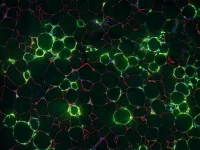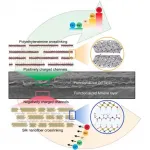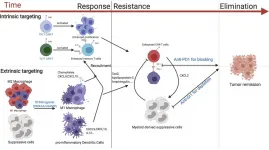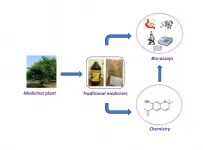(Press-News.org) WHAT:
The investigational vaccine known as mRNA-1273 was 94.1% efficacious in preventing symptomatic coronavirus disease 2019 (COVID-19), according to preliminary results from a Phase 3 clinical trial reported in the New England Journal of Medicine. The vaccine also demonstrated efficacy in preventing severe COVID-19. Investigators identified no safety concerns and no evidence of vaccine-associated enhanced respiratory disease (VAERD).
The vaccine was co-developed by Moderna, Inc., a biotechnology company based in Cambridge, Massachusetts, and the National Institute of Allergy and Infectious Diseases (NIAID), part of the National Institutes of Health. Moderna and NIAID previously shared initial results from the COVE trial. On Dec. 18, 2020, the FDA issued an Emergency Use Authorization allowing Moderna to make the vaccine available for the prevention of COVID-19 in adults in the United States.
The trial was led by principal investigators Lindsey R. Baden, M.D. of Brigham and Women's Hospital in Boston, Hana M. El-Sahly, M.D. of Baylor College of Medicine in Houston, and Brandon Essink, M.D., of Meridian Clinical Research. The trial was implemented under the U.S. government's Operation Warp Speed program and supported by NIAID and the Biomedical Advanced Research and Development Authority (BARDA) of the U.S. Department of Health and Human Services' Office of the Assistant Secretary for Preparedness and Response.
The trial began on July 27, 2020, and enrolled 30,420 adult volunteers at clinical research sites across the United States. Volunteers were randomly assigned 1:1 to receive either two 100 microgram (mcg) doses of the investigational vaccine or two shots of saline placebo 28 days apart. The average age of volunteers is 51 years. Approximately 47% are female, 25% are 65 years or older and 17% are under the age of 65 with medical conditions placing them at higher risk for severe COVID-19. Approximately 79% of participants are white, 10% are Black or African American, 5% are Asian, 0.8% are American Indian or Alaska Native, 0.2% are Native Hawaiian or Other Pacific Islander, 2% are multiracial, and 21% (of any race) are Hispanic or Latino.
From the start of the trial through Nov. 25, 2020, investigators recorded 196 cases of symptomatic COVID-19 occurring among participants at least 14 days after they received their second shot. One hundred and eighty-five cases (30 of which were classified as severe COVID-19) occurred in the placebo group and 11 cases (0 of which were classified as severe COVID-19) occurred in the group receiving mRNA-1273. The incidence of symptomatic COVID-19 was 94.1% lower in those participants who received mRNA-1273 as compared to those receiving placebo.
Investigators observed 236 cases of symptomatic COVID-19 among participants at least 14 days after they received their first shot, with 225 cases in the placebo group and 11 cases in the group receiving mRNA-1273. The vaccine efficacy was 95.2% for this secondary analysis.
There were no concerning safety issues with vaccination, according to the authors. Local reactions to the vaccine were generally mild. About 50% of participants receiving mRNA-1273 experienced moderate-to-severe side effects--such as fatigue, muscle aches, joint pain and headache--after the second dose, which resolved in most volunteers within two days.
Investigators also observed no evidence of VAERD among those who received mRNA-1273. This rare complication was seen in individuals vaccinated with a whole-inactivated respiratory syncytial virus (RSV) vaccine in the 1960s, before there was a capacity to define protein structures and measure immune responses with precision. VAERD can occur when a vaccine induces an immune response that is not strong enough to protect against infection.
Although mRNA-1273 is highly efficacious in preventing symptomatic COVID-19, there is not yet enough available data to draw conclusions as to whether the vaccine can impact SARS-CoV-2 transmission. Preliminary trial data suggests there may be some degree of prevention of asymptomatic infection after a single dose. Additional analyses are underway of the incidence of asymptomatic infection and viral shedding post-infection to understand the vaccine's impact on infectiousness.
The authors concluded by discussing the unprecedented efficiency of the candidate vaccine's development, noting, "this process demonstrates what is possible in the context of motivated collaboration among key sectors of society including academia, government, industry, regulators and the larger community."
INFORMATION:
ARTICLE:
LR Baden et al. Efficacy and Safety of mRNA-1273 SARS-CoV-2 Vaccine. New England Journal of Medicine DOI: 10.1056/NEJMoa2035389 (2020).
WHO:
NIAID Director Anthony S. Fauci, M.D. is available to comment on this study. John R. Mascola, M.D., director of NIAID's Vaccine Research Center, is also available to comment.
CONTACT:
To schedule interviews, please contact the NIAID News & Science Writing Branch,
(301) 402-1663,
niaidnews@niaid.nih.gov.
NIAID conducts and supports research--at NIH, throughout the United States, and worldwide--to study the causes of infectious and immune-mediated diseases, and to develop better means of preventing, diagnosing and treating these illnesses. News releases, fact sheets and other NIAID-related materials are available on the NIAID website.
About the National Institutes of Health /NIH, the nation's medical research agency, includes 27 Institutes and Centers and is a component of the U.S. Department of Health and Human Services. NIH is the primary federal agency conducting and supporting basic, clinical, and translational medical research, and is investigating the causes, treatments, and cures for both common and rare diseases. For more information about NIH and its programs, visit http://www.nih.gov/.
NIH...Turning Discovery Into Health®
"Today's computer applications generate a large amount of data that needs to be processed by machine learning algorithms," says Yeseong Kim of Daegu Gyeongbuk Institute of Science and Technology (DGIST), who led the effort.
Powerful 'unsupervised' machine learning involves training an algorithm to recognize patterns in large datasets without providing labelled examples for comparison. One popular approach is a clustering algorithm, which groups similar data into different classes. These algorithms are used for a wide variety of data analyses, such as identifying fake news on social media, filtering spam in our e-mails, and detecting ...
DALLAS - Dec. 30, 2020 - When fat cells in the body are stuffed with excess fat, the surrounding tissue becomes inflamed. That chronic, low-level inflammation is one of the driving factors behind many of the diseases associated with obesity. Now, UT Southwestern scientists have discovered a type of cell responsible, at least in mice, for triggering this inflammation in fat tissue. Their findings, published in Nature Metabolism, could eventually lead to new ways to treat obesity.
"The inflammation of fat cells in obese individuals is linked to many of the ...
Lithium is an energy-critical element that is considered to be a geopolitically significant resource. However, the supply of lithium may not be enough to meet continuously increasing demand. As a result, scientists are looking for new ways to extract lithium ions.
Ion selective membranes have already been used extensively for water treatment and ion sieving in electrodialysis technology. However, conventional membranes exhibit low and useless Li+ selectivity, making them insufficient for meeting industry requirements.
Chinese scientists have recently made progress in the preparation and application of a bioinspired ...
Arctic sea ice has been rapidly declining in recent decades, and changes in arctic sea ice can have a significant impact on global weather and climate through interactions with the atmosphere and oceans. In addition, the Arctic shipping routes are a shortcut to connect the major countries in the Northern Hemisphere. The Arctic region is also rich in natural resources and biological resources. Simulation of the Arctic sea ice could provide valuable information for Arctic shipping as well as climate studies, and it is therefore urgent to evaluate the ability to simulate Arctic sea ice and diagnose the sources of simulation errors.
To address the issue of error source identification, ...
Experts in optical physics have developed a new way to see inside living cells in greater detail using existing microscopy technology and without needing to add stains or fluorescent dyes.
Since individual cells are almost translucent, microscope cameras must detect extremely subtle differences in the light passing through parts of the cell. Those differences are known as the phase of the light. Camera image sensors are limited by what amount of light phase difference they can detect, referred to as dynamic range.
"To see greater detail using the same image sensor, we must expand the dynamic range so that we can ...
Activating an immune signaling pathway best known for fighting viral and bacterial infections can boost the ability of genetically engineered T cells to eradicate breast cancer in mice, according to a new study by researchers at the University of North Carolina. The study, to be published December 31 in the Journal of Experimental Medicine (JEM), suggests that CAR T cells, which are already used to treat certain blood cancers in humans, may also be successful against solid tumors if combined with other immunotherapeutic approaches.
Chimeric antigen receptor (CAR) T cells are a type of white blood cell that have been genetically engineered to recognize ...
The Asian tiger mosquito does not pose a major risk for Zika virus epidemics, according to a study published December 31 in the open-access journal PLOS Pathogens by Albin Fontaine of the Institut de Recherche Biomédicale des Armées, and colleagues.
Zika virus has triggered large outbreaks in human populations, in some cases causing congenital deformities, fetal loss, or neurological problems in adults. While the yellow fever mosquito Aedes aegypti is considered the primary vector of Zika ...
A novel computational drug screening strategy combined with lab experiments suggest that pralatrexate, a chemotherapy medication originally developed to treat lymphoma, could potentially be repurposed to treat Covid-19. Haiping Zhang of the Shenzhen Institutes of Advanced Technology in Shenzhen, China, and colleagues present these findings in the open-access journal PLOS Computational Biology.
With the Covid-19 pandemic causing illness and death worldwide, better treatments are urgently needed. One shortcut could be to repurpose existing drugs that were originally developed to ...
Multiple bouts of blood feeding by mosquitoes shorten the incubation period for malaria parasites and increase malaria transmission potential, according to a study published December 31 in the open-access journal PLOS Pathogens by Lauren Childs of Virginia Tech, Flaminia Catteruccia of the Harvard T.H. Chan School of Public Health, and colleagues. Given that mosquitoes feed on blood multiple times in natural settings, the results suggest that malaria elimination may be substantially more challenging than suggested by previous experiments, which typically involve a single blood meal.
Malaria ...
The discovery of new drugs is vital to achieving the eradication of neglected tropical diseases (NTDs) in Africa and around the world. Now, researchers reporting in PLOS Neglected Tropical Diseases have identified traditional Ghanaian medicines which work in the lab against schistosomiasis, onchocerciasis and lymphatic filariasis, three diseases endemic to Ghana.
The major intervention for NTDs in Ghana is currently mass drug administration of a few repeatedly recycled drugs, which can lead to reduced efficacy and the emergence of drug resistance. Chronic infections of schistosomiasis, onchocerciasis and lymphatic filariasis ...










